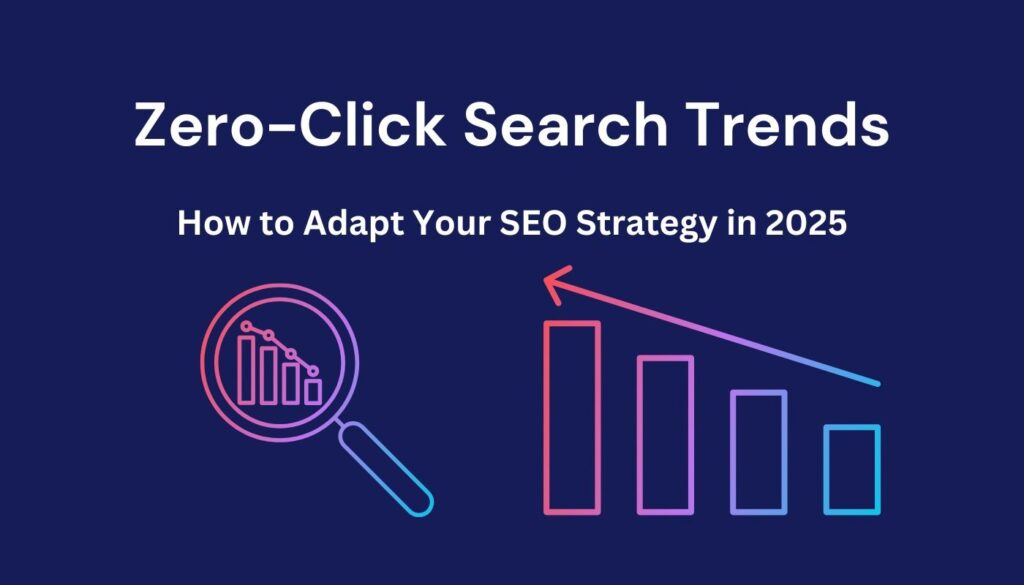

Zero-click searches have been reshaping the SEO landscape for years, and their importance continues to grow in 2025. But what exactly are zero-click searches, and how do they impact your website’s visibility? This blog answers these questions and explains how to adapt your SEO strategy effectively.
Zero-click search trends describe searches in which users receive answers directly on the search engine results page (SERP) without needing to click any links. These results come from featured snippets, knowledge panels, or other instant-answer features. Let’s dive deeper into this topic and explore how you can ensure your website stays relevant.
Zero-click searches occur when search engines provide users with immediate answers, eliminating the need to click through to a website. This often happens for:
For example, searching for “current time in New York” shows the result directly on Google’s SERP. While convenient for users, it creates challenges for websites seeking organic traffic.

There are several reasons behind the rise of zero-click searches:
According to a recent study by HubSpot, nearly 50% of all searches in 2024 ended without a click. This trend is expected to increase further in 2025.
The Impact on Organic Click-Through Rates
Zero-click searches reduce the number of users clicking on organic search results. This means:
Effect on Search Visibility
Your website’s visibility depends not only on ranking high but also on appearing in zero-click elements. Structured data markup and localized content can help secure these spots.

1. Use Structured Data Markup
Structured data helps search engines understand your content. By implementing schema markup, you increase the chances of your content appearing as a rich snippet or knowledge panel. Some useful types of schema include:
• FAQ Schema
• Local Business Schema
• Product Schema
Google’s Structured Data Guidelines is a great resource to learn more.
2. Optimize for Featured Snippets
To appear in featured snippets:
• Use clear, concise answers to common questions.
• Format content with bullet points, tables, and headings.
• Focus on long-tail keywords and search queries.
For example, if your business provides SEO services, answer questions like “What is SEO strategy evolution?” in your blog content.
3. Focus on Local Search Optimization
Local businesses can benefit significantly from zero-click searches. To optimize:
• Claim and optimize your Google Business Profile.
• Include your business hours, address, and phone number.
• Use location-based keywords.
For instance, internal linking to your local SEO services page can drive more traffic to relevant areas of your website.
4. Create High-Quality Content
Content that is informative, user-focused, and engaging increases the likelihood of being used in zero-click features. Keep in mind:
• Answer search intent effectively.
• Use LSI keywords naturally throughout your content.
• Link to reputable external sources like Wikipedia or industry blogs.
5. Monitor Predictive Search Trends
Search engines are becoming better at predicting user behavior. Tools like Google Search Console can help you track:
• Changes in impressions and CTR for queries.
• How users interact with your content on the SERP.
6. Adapt Your SEO Strategy Evolution
SEO isn’t static. Regularly update your strategy to align with search engine algorithms and user behavior. Internal linking to your blogs on algorithm updates or SEO tips can keep readers informed and engaged.
While AI technologies make search engines smarter, they also pose challenges for content creators. By focusing on:
Personalized Content
AI allows search engines to understand user preferences and deliver tailored results. As a content creator, crafting personalized content that addresses specific audience needs can improve your chances of ranking. For instance, creating articles that cater to niche audiences or answer detailed questions enhances engagement and relevance.
Data-Driven Insights
Data-driven insights refer to the use of analytics and tools to understand search behavior. Leveraging platforms like Google Analytics can help you track user interactions and refine your content strategy. This ensures your content aligns with what users are actively searching for, boosting your visibility in AI-driven search results.
Visual Search Optimization
Visual elements like images and videos are increasingly prioritized by AI. Optimizing your visuals with proper alt text, metadata, and captions makes them more discoverable. Additionally, creating high-quality visuals that align with user queries can improve your chances of appearing in rich snippets and other AI-powered search features.

Predictive search trends indicate that zero-click searches will continue to dominate. To stay ahead, businesses must:
Invest in Voice Search Optimization
Voice searches are becoming more popular, driven by AI assistants like Alexa and Google Assistant. Optimizing for voice search involves using natural language in your content and targeting conversational queries. For example, instead of “best SEO tips,” you could target “What are the best tips for SEO in 2025?” to align with how people speak during voice searches.
Build Strong Brand Recognition to Drive User Trust
In an era of zero-click searches, brand recognition plays a crucial role. Users are more likely to trust and engage with familiar brands. Building your brand involves consistent messaging, maintaining an active online presence, and delivering value through your content. Strong branding ensures users remember your business, even if they don’t click through immediately.
Focus on Long-Tail Keywords with High Intent
Long-tail keywords are specific and often less competitive, making them ideal for targeting user intent. These keywords usually indicate a readiness to act, such as “best SEO agency for local businesses” or “affordable content marketing services near me.” By creating content around these terms, you cater to users who are closer to making decisions, improving your conversion potential.
By addressing these areas, businesses can navigate the challenges posed by AI-powered search results and thrive in the evolving digital landscape.
Zero-click search trends are changing the SEO game. While they reduce click-through rates, they also open up opportunities to showcase your content directly on SERPs. By optimizing for featured snippets, structured data, and local search, you can ensure your website remains visible and relevant. Start adapting your strategy today to thrive in the evolving digital landscape of 2025.
Explore more about SEO and digital marketing strategies on our blog page or check out our services to see how we can help you achieve your goals.
Zero-click searches refer to search queries where users receive the answers they need directly on the search engine results page (SERP) without clicking on any links. These answers are usually displayed in featured snippets, knowledge panels, or other SERP features.
Zero-click searches are growing due to advancements in search engine algorithms, the rise of voice search, and Google's focus on enhancing user experience. Features like structured data and rich snippets allow search engines to provide instant answers.
Zero-click searches reduce organic click-through rates (CTR) since users get the information they need without visiting a website. This challenges businesses to optimize for SERP features to maintain visibility.
You can optimize by:
Structured data markup is code added to your website to help search engines understand your content better. It increases the chances of appearing in rich results, such as featured snippets or knowledge panels, making your content more visible.
Yes, local businesses can gain significant visibility through zero-click searches. Optimizing Google Business Profile, adding accurate contact details, and using location-based keywords help capture local search traffic.